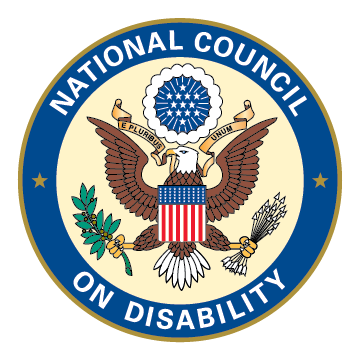Statement for the Record - House Subcommittee on Early Childhood, Elementary, and Secondary Education
Statement for the Record
U.S. House of Representatives
Committee on Education & Workforce
Subcommittee on Early Childhood, Elementary, and Secondary Education
“Reimagining Education: How Charter Schools Are Closing Gaps and Opening Doors”
May 21, 2025
Chairman Kiley, Ranking Member Bonamici, and Members of the Subcommittee on Early Childhood, Elementary, and Secondary Education:
On behalf of the National Council on Disability (NCD), an independent federal agency charged with providing advice to Congress and the President and his Administration on the impact of federal policies on the lives of people with disabilities, we commend the Committee for exploring the impact of charter schools on the education of students in your recent education hearings, and we thank you for the opportunity to submit a Statement for the Record on this topic to help inform the Subcommittee Members about NCD’s research into the topic.
In 2018, NCD published Charter Schools - Implications for Students with Disabilities[^1], which examined the education of students with disabilities in charter schools, the barriers experienced by students and their families, and models of success. While some charter schools experience serious challenges in the provision of special education programming and services, NCD identified other programs that have developed innovative approaches that have succeeded in meeting the unique educational needs of students with disabilities.
In conducting this research, NCD utilized a mixed-methods approach that included analysis of existing policies and secondary literature, and an examination of qualitative data. Policy and literature reviews analyzed key federal and state statutes, regulations, and administrative guidance as well as relevant case law and administrative due process hearings. As a key component of this research, NCD incorporated the perspectives of interested stakeholders by holding a series of six focus groups with parents and parent advocates in different regions across the country. In addition, NCD held eighteen semi-structured interviews with state department of education officials, teachers, administrators, representatives of charter school organizations, representatives of disability organizations, parents of students with disabilities, and parent advocates.
NCD first found that a special education enrollment gap exists between charter schools and traditional public schools. Charter schools generally enroll lower percentages of students with disabilities than traditional public schools and identified factors underlying this enrollment gap to include: (1) Parents of students with disabilities are less likely to apply to charter schools. Reasons include that students with disabilities may already be connected to specialized programs within traditional public schools or that charter schools may be discouraging parents of students with disabilities from applying to the school; (2) Charter schools are more likely to declassify and less likely to classify students as needing special education services than traditional public schools; and (3) The existence of qualitative, anecdotal reports of charter schools engaging in the practice of “counseling out” students with disabilities who are enrolled in these schools, including for discipline or behavior-related issues.
Next, NCD’s report identified factors that created challenges for charter schools in delivering appropriate educational services to students with disabilities as required under the Individuals with Disabilities Education Act (IDEA). These challenges include (1) limited knowledge and understanding of special education responsibilities and requirements on the part of some charter operators and charter authorizers; (2) limited availability of special education funds that are distributed in complex ways; and (3) potential tension between the charter school movement’s underlying principles related to autonomy and flexibility and special education requirements. This tension manifests itself in a number of ways: for example, tension stemming from some charter schools’ implementation of strict academic and behavioral expectations that clash with the rights of students with disabilities with respect to discipline under IDEA, as well as tension between the parental choice focus of the charter movement and the Individualized Education Program (IEP) team based decision-making process of IDEA.
To find and offer solutions to these educational challenges, NCD analyzed emerging educational policies in charter schools that could be potential models of success for policymakers in providing special educational programming to students with disabilities. NCD examined the National Center for Special Education in Charter Schools’ (NCSECS) model policy guide, which provides an innovative framework to assist policymakers in developing successful practices that mitigate potential harm to students with disabilities. Specifically, NCD’s report highlighted Paramount School of Excellence in Indianapolis (Paramount). At the time of NCD’s research, Paramount served seven hundred students in grades K–8 and had a special education enrollment rate that was comparable to that of the Indianapolis School District (18.5 percent versus 18 percent, respectively). Paramount’s high expectations for students were set forth in a series of policy and instructional guidelines or “Frameworks.” These Frameworks created clear goals for all students and helped ensure that students with disabilities did not receive a watered-down curriculum or taught to standards that were below grade level. The classrooms allowed flexibility to accommodate the needs of all students regardless of whether they had an Individualized Education Plan. The school also utilized a combination of a co-teaching, and a purposeful resource room support model along ongoing collaboration between special education, general education personnel, administrators, and teachers. Lastly, teachers regularly updated student performance data to guide subsequent instruction.
NCD encourages the Subcommittee to also review the profiles of other charter schools that NCSECS describes as “Centers for Excellence,” which have the potential to serve as educational models for charter schools generally.
NCD agrees with the subcommittee that every student deserves a high-quality education that prepares him or her for success later in life. We thank the Subcommittee for allowing us to share important highlights and recommendations from our 2018 charter school report in the shared interest of improving educational experiences and outcomes for students with disabilities.
Sincerely,
David Shawn Kennemer Acting Chair / Vice Chair National Council on Disability
-—————–
[^1] National Council on Disability, Charter Schools – Implications for Students with Disabilities, (November 15, 2018), available at: https://www.ncd.gov/assets/uploads/reports/2018/ncd-charter-schools-2018.pdf

